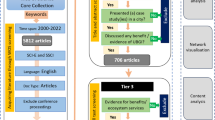Abstract
Sustainability has become the transdisciplinary buzzword of urbanism. Sustainability can be leveraged as an integrated tool that can fortify design and redesign of urban forms that are deemed ‘unsustainable’. For this study, sustainability is given criteria, following the methodology of Frey, and applied to the redesign of an actual existing city. This methodology reorganizes cities or districts into ‘urban quarters’, which are modular units within the city. In this manner, the city of Eindhoven, The Netherlands was taken as a case study and the sustainability criteria given by Frey’s method were used to analyse and identify the levels of sustainability in urban quarters in Woensel, a district of Eindhoven. The results indicate that a grand part of the evaluated areas as unsustainable possess characteristics that diagnose a loss of modularity principally in the quarters in the north of Woensel. A redesign proposal is presented, to modularly restructure the district Woensel. The development of a large urban unit is carried out as example, through the union of sustainable and unsustainable areas.








Similar content being viewed by others
References
Barton, H. (2000) Sustainable Communities, the Potential of Eco-Neighborhoods London: Earthscan.
Beekman, P.C. (1982) Eindhoven: Stadsontwikkeling 1900–1960 Mierlo, The Netherlands: Eigen Uitgave.
Breheny, M., Williams, K., Jenks, M. and Burton, E. (1996) The Compact City: A Sustainable Urban Form? London: E & FN Spon.
Buchanan, M. (2002) Small World: Uncovering Nature’s Hidden Networks London: Phoenix, New ED Edition.
Davidson, M. (2010) Sustainability as ideological praxis: The acting out of planning’s master-signifier. City 14 (4): 390–405.
Doevendans, K. (2005) Het Wij van Wijkgedachte. De biografie van een stedebouwkundig subject. In: F. Sanders (ed.) Reflecties op het woondomein Eindhoven, The Netherlands: Bouwstenen Publicaties.
Doevendans, K. (2009) De ontphilipste stad, kansen voor architectuurbeleid in Eindhoven Eindhoven, The Netherlands: Technische Universiteit Eindhoven.
Doevendans, K. and Schram, A. (2005) Creation/accumulation city. Theory Culture & Society 22 (2): 29–43.
Doust, K. (2014) Toward a typology of sustainability for cities. Journal of Traffic and Transportation Engineering 1 (3): 180–195.
Ehlers, E. (2011) City models in theory and practice: A cross-cultural perspective. Urban Morphology 15 (2): 97–119.
Frey, H. (1999) Designing the City: Towards a More Sustainable Urban Form London: Spon Press.
Frey, H. and Yaneske, P. (2007) Visions of Sustainability, Cities and Regions New York: Taylor & Francis.
Frey, H., Bagaeen, S., Gianchis, C. and Faria, P. (2010) Urbanising suburbia: The handbook. Establishing threshold, average and target values of sustainable urban quarters, Report in city-form.org.uk, http://www.city-form.org/uk/pdfs/CityForm_US_Handbook.pdf.
Grigonis, V. (2013) World cities and urban form: Fragmented, polycentric, sustainable? Urban Design International 18 (2): 182–183.
Jabareen, Y. (2006) Sustainable urban forms: Their typologies, models and concepts. Journal of Planning Education and Research 26 (1): 38–52.
Jenks, M. and Dempsey, N. (2005) Future Forms and Design for Sustainable Cities Oxford: Architectural Press.
Jenks, M. and Jones, C. (2010) Dimensions of the sustainable city. vol 2. Dordrecht: Springer.
Jones, H. and Jones, P. (2007) Cities and sustainability. Landscape and Urban Planning 83 (1): 1.
Karimi, K. (2013) Retrofitting suburbia: Urban design solutions for redesigning suburbs. Journal of Urban Design 18 (1): 168–170.
Kärrholm, M. (2011) The scaling of sustainable urban form: A case of scale-related issues and sustainable planning in Mälmo, Sweden. European Planning Studies 19 (1): 97–112.
Krier, L. and Thadani, D. (2009) The Architecture of Community London: Island Press.
Krier, L. (1984) The city within the city. Architectural Design 54 (1): 70–105.
Luederitz, C., Lang, D.J. and Von Wehrden, H. (2013) A systematic review of guiding principles for sustainable urban neighbourhood development. Landscape and Urban Planning 188 (10): 40–52.
Neuman, M. (2005) The compact city fallacy. Journal of Planning Education and Research 25 (1): 11–26.
Pfeiffer, D. (2014) Retrofitting suburbia through second units: Lessons from the Phoenix Region, Journal of Urbanism: International Research on Placemaking and Urban Sustainability 8 (3): 279–301.
Rutgers, R.A. and Custers, L. (2005) Historich Morfologische Atlas van Eindhoven Eindhoven: Gemeente Eindhoven.
Schippers, H., Bosman, J. and Doevendans, K. (2007) City-plan Eindhoven (1967–1970): het modernste ontwerp voor de stad Eindhoven, The Netherlands: Walburg Pers.
Sorensen, A. (2001) Subcentres and satellite cities: Tokyo’s 20th century experience of planned polycentrism. International Planning Studies 6 (1): 9–32.
UN-Habitat. (2009) Global Report of Human Settlements 2009: Planning Sustainable Cities. United Nations Human Settlements Programme: UN-Habitat, Nairobi, Kenya.
Vall-Casas, P., Koschinsky, J. and Mendoza, C. (2011) Retrofitting suburbia through pre-urban patterns: Introducing a European perspective. Urban Design International 16 (3): 171–187.
WCED. (1987) Our Common Future. The Brundtland Report, World Commission for Environment and Development Oxford: Oxford University Press.
Winston, N. (2013) Sustainable communities? A comparative perspective on urban housing in the European union. European Planning Studies 22 (7): 1387–1406.
Author information
Authors and Affiliations
Corresponding author
Rights and permissions
About this article
Cite this article
Zumelzu, A., Doevendans, K. Modularity and sustainability: Eindhoven as an example of pragmatic sustainable design. Urban Des Int 21, 93–110 (2016). https://doi.org/10.1057/udi.2015.14
Published:
Issue Date:
DOI: https://doi.org/10.1057/udi.2015.14




